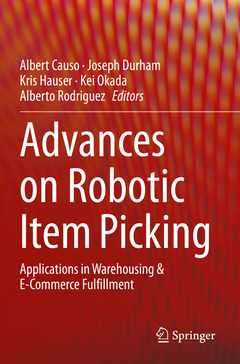Description
Advances on Robotic Item Picking, 1st ed. 2020
Applications in Warehousing & E-Commerce Fulfillment
Coordinators: Causo Albert, Durham Joseph, Hauser Kris, Okada Kei, Rodriguez Alberto
Language: English
Subjects for Advances on Robotic Item Picking:
Publication date: 05-2021
Support: Print on demand
Publication date: 05-2020
152 p. · 15.5x23.5 cm · Hardback
Description
/li>Contents
/li>Biography
/li>Comment
/li>
Albert Causo is a Senior Research Fellow at the Robotics Research Centre, School of Mechanical and Aerospace Engineering, Nanyang Technological University (NTU), Singapore. He obtained his masters and Ph.D. in Information Science from Nara Institute of Science and Technology in 2006 and 2010, respectively. His research interests include computer vision, human-robot interaction, human motion measurement, human posture tracking and modelling, rehabilitation robotics, robot-assisted education and, grasping strategy in item picking for professional services and logistics robot for warehouse fulfillment.
Joey Durham is Manager of Research and Advanced Development at Amazon Robotics. His team focuses on resource allocation algorithms, machine learning, and path planning for robotic warehouses. He also runs the Amazon Picking Challenge robotic manipulation contest. Joey joined Kiva Systems after completing his Ph.D. at the University of California at Santa Barbara in distributed coordination for teams of robots. He has been with the company through its acquisition and growth into Amazon Robotics. Previously he worked on path planning for autonomous vehicles at Stanford University for the DARPA Grand Challenge.
Kris Hauser is an Associate Professor at the Pratt School of Engineering at Duke University with a joint appointment in the Electrical and Computer Engineering Department and the Mechanical Engineering and Materials Science Department. He received his PhD in Computer Science from Stanford University in 2008, bachelor's degrees in Computer Science and Mathematics from UC Berkeley in 2003, and worked as a postdoctoral fellow at UC Berkeley. He then joined the faculty at Indiana University from 2009-2014, where he started the Intelligent Motion Lab. He is a recipient of a Stanford Graduate Fellowship, Siebel Scholar Fellowship, and the NSF CAREER award.
Kei Okada received theMS and

